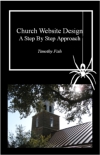
And Thy House
Extra Feature: High Res Image

History of
Cane Creek
Association
by D. F. Magruder
Church Size
Written By: Timothy Fish Published: 6/26/2006
The way people classify churches by size is rather interesting. Usually, it is fairly arbitrary. One person will say that a small church is anything with an average attendance under two hundred while someone else might say a small church is anything with an average attendance under fifty. On personís medium size church might go up to a size of one thousand while another will say they go up to three hundred. Seldom does anyone give justification for the sizes they select. This article presents yet another size classification for churches, but it also explains the reason behind the classification.
It is generally accepted that there are four classifications of churches, small, medium, large and mega. This article will add one more, tiny, as a subclass of small churches. It seems to be commonly accepted that the best way to classify a church is by average attendance rather than membership. Some churches have membership numbering several times the average attendance. Some of the people on the church rolls may have moved to a different church without informing the church or may have died and the church is unaware of it. Members that do not assemble with the church are members in name only and should not be considered when calculating church size.
Church size classifications are intended to be a means of describing a church. Rather than just picking a number, it would be better to group churches together based on characteristics that are influenced by the size. Consider the mega churches. These are the big boys on the block. These churches are the ones that are most likely to be accused by churches with similar beliefs of compromising on doctrinal issues in order to increase their size. Unfortunately, this is true in some cases, but for the purpose of classifying a church by size, a churchís doctrinal stand has no meaning. The thing that best classifies a mega church is that it is a place where a person can get lost in the crowd. Most of them have many ministry areas from which people who want to be involved can choose, but a stranger can walk into the church and no one will know whether he is a guest or he has been attending the church for weeks. Because of the size of the church, no one would know whether the stranger is actively involved in the churchís ministry or not. The number of people it takes to reach this point is uncertain. It could be as low as one thousand with some churches, but in churches where most people attend every week it might be even higher.
Large churches generally donít have the financial resources that mega churches have. They also lack the ability to implement as many programs, but they generally are able to do some things in addition to their high priority items. They usually have several full time staff members. Because these churches are smaller than mega churches it requires a little more work for a person to get lost in the crowd. A stranger who comes off the street may not be recognized as a newcomer by those who sit in the same area as he does, but there will probably be someone who recognizes that he has not been there before or at least not very much. The fact that most people sit in about the same spot every week helps with this.
Medium sized churches are characterized by the fact that it is possible for one person to know all of the people who attend regularly, but not everyone does. If the church has a prayer list, several church members can reasonably expect to be able to recognize all the church members who are on the list. Even though some church members, perhaps the pastors, feel like they know all of the people who attend each week, there will be some people who do not. The upper limit of a medium sized church is about 250. Few people can mentally track more than that number of people at one time. If a lot of people within the church tend to attend every other week or less then the medium level might be reached with a much lower average attendance.
There are many different reasons why a church is small. New church plants start out small. A church that is dieing may be small. A church in a sparsely populated area might be small. A church that is very restrictive about who may join may be small. The one thing that small churches have in common is that everyone knows everyone. Unlike medium sized churches where only a handful of people can say they know everyone, in a small church all of the people who attend regularly know all the other people who attend regularly. The maximum size where this is possible is probably between seventy-five and ninety people in most cases. By their very nature, small churches have a family like atmosphere that many larger churches go to a lot of trouble to replicate. Small churches donít have some of the nice features that larger churches have, but when a stranger walks in off the street everyone realizes that he is a newcomer. Small churches usually donít have the money to pay their pastor full-time.
The smallest a small church can be is two people. Obviously, there is a significant difference between a church with two people and a church with fifty people. There are some small churches that are so small that they can only be classified as tiny. If an arbitrary number was chosen it would probably be any church with less than fifteen members. These churches are constantly on the line between dieing and growing, but some of them go for years without any increase or decrease in membership or average attendance. Programs of any kind are generally out of the question for these churches.
One might wonder what size is ideal for a church. Some people pick a church to attend based primarily on size. There really is no ideal size for a church. Every church should desire to have an average attendance that is one more than what it is right now. Some of the early churches were mega churches while others were small enough to meet in peopleís homes. There is no biblical standard for the ideal size of a church. For a person looking for a church, the size of the church should be secondary to the issue of doctrine and that of where the person can serve the Lord.
www.timothyfish.com



